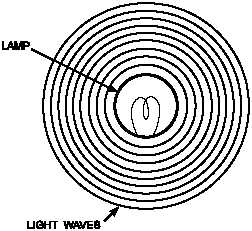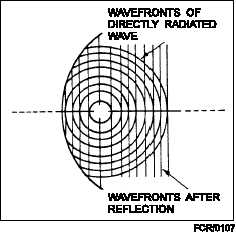out equally in all directions, as shown in figure 1-6.
Figure 1-6 compares the radiation from a radio antenna
with that from a lamp.
Both light waves and radio
waves are electromagnetic radiation; the two are
believed to be identical, except in frequency of
vibration.
From both sources, energy spreads out in
spherical waves. Unless they meet some obstruction,
these waves will travel outward indefinitely at the
speed of light.
The energy at any given point decreases with range
since the wave, and therefore the energy, is spreading
out to cover a larger area. Because of its much higher
frequency, light has a much shorter wavelength than a
radio wave. This is suggested in figure 1-6 but it cannot
be shown accurately to scale. The wavelength of radar
transmission may be measured in centimeters, whereas
the wavelength of light varies from about three to seven
ten-thousandths of a millimeter. We mentioned earlier
that radio wave energy must be concentrated to be
useful. We can concentrate this energy by mounting a
suitable reflector behind the antenna, to form a large
part of the radiated energy into a relatively narrow
beam.
The following paragraphs discuss the more
commonly used reflectors.
PARABOLIC REFLECTORS.—You should be
familiar with the use of polished reflectors to form
beams of light.
An automobile headlight uses a
parabolic reflector to produce a fairly wide beam.
A
spotlight uses a slightly differently shaped parabolic
reflector to produce a more narrow beam.
A type of reflector generally used in missile
fire-control radars is the parabolic dish. It is similar in
appearance to the reflector used in an automobile
headlight.
Since radar operates in the microwave
region of the electromagnetic spectrum, its waves have
properties and characteristics similar to those of light.
This permits radar antennas to be designed using
well-known optical design techniques.
A basic principle of optics is that a light ray
striking a reflecting surface at a given angle will reflect
from that surface at the same angle. Now refer to figure
1-7.
Think of the circular wavefronts generated by
source F as consisting of an infinite number of rays.
The antenna’s parabolic reflecting surface is designed,
using the reflection principle, so that as the circular
wavefronts strike the reflector, they are reflected as
straight wavefronts.
This action concentrates them
into a narrow circular beam of energy.
HORN RADIATORS.—Horn radiators (fig.
1-8), like parabolic reflectors, may be used to create
concentrated electromagnetic waves.
Horn radiators
are readily adaptable for use with waveguides because
they serve both as an impedance-matching device and
1-8
LIGHT
RADIO
Figure 1-6.—Radiation waves from a radio antenna
and a lamp.
F
Figure 1-7.—Principles of the parabolic reflector.






